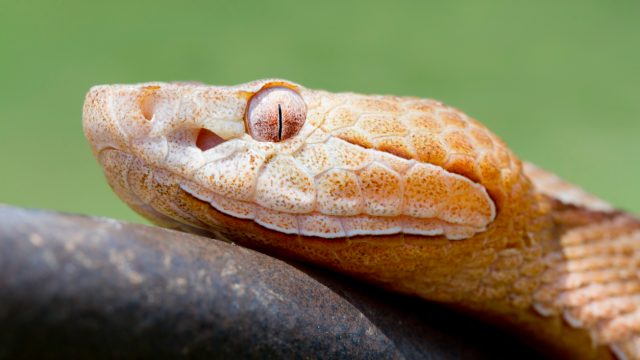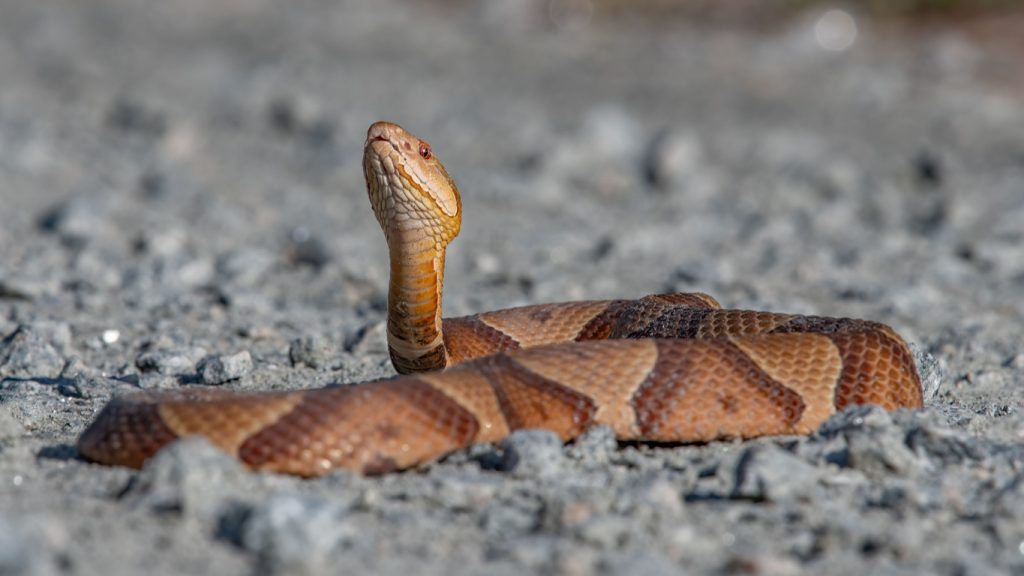14-Year-Old Bitten by Copperhead in His Garage—Here’s How It Got There

Even though they play a vital role in the ecosystem, venomous snakes like copperheads are not the kind of animal you necessarily want to making a surprise visit to your home. The non-aggressive reptiles can sometimes defend themselves with their dangerous bite, leading to some seriously harrowing medical emergencies. This includes one recent instance where a teenager was hospitalized after he was bitten by a copperhead while playing at home. Read on to see where the reptile was hiding and how you can avoid these types of situations.
READ THIS NEXT: 8 Things in Your Yard That Are Attracting Snakes to Your Home.
A teenage boy was seriously injured after being bitten by a copperhead in his home.

We all remember the scrapes and bumps we endured while playing outdoors during summer vacation as kids. But one North Carolina boy had a serious medical emergency after a run-in with a venomous snake while at home.
On June 10, 14-year-old Benjamin Levy was playing basketball with his younger siblings nearby, local FOX affiliate WJZY reports. But when he went to go back inside, a venomous reptile took him by surprise.
“He opened up the garage door, and waiting for him was a copperhead,” Joel Levy, the boy’s father, told WJZY.
The boy’s father quickly reached out for help identifying the snake.

The surprise encounter resulted in a painful bite that landed between Benjamin’s toes. But the teen acted quickly by running to grab his 2-year-old brother and heading inside to alert his father.
“He came running in and said, ‘Dad, I think I just got bit,’ I looked at his foot, and it was quite bloody,” Levy told WJZY.
Joel said his next step was to try to identify the reptile that had bitten his son, turning to social media in an effort to get a quick answer. “I frankly posted something on Facebook that said, ‘Hey, just for verification, is this, in fact, a copperhead?'” he told the news outlet.
RELATED: For more up-to-date information, sign up for our daily newsletter.
Joel said his son ignored two important pieces of advice before the accident.

Once it was verified that the snake in question was a copperhead, Joel took his son to a nearby hospital for medical attention. Fortunately, doctors had copperhead antivenom on hand to treat the injury—even though it came with a high price tag that Levy says eventually came out to roughly $60,000, he told WJZY.
In light of the event, Levy says he hopes his son’s ordeal will serve as a reminder to other families to keep an eye out for potentially dangerous venomous snakes like copperheads. But he did point out that Benjamin has already admitted to not following some simple safety rules leading up to his close encounter.
“I continuously tell my children—and I have six—they need to close the garage door because, I say, snakes will want to go inside,” Levy told WJZY. “And I say, ‘Hey, if you’re going to go outside you need to wear shoes.’ And so my son is taking this in very good humor, has laughed, and said, ‘I guess, dad, you were right.'”
Here’s how to avoid getting bitten by a copperhead snake—and what you should do in an emergency.

While it’s practically impossible to avoid all run-ins with snakes, there are still a few ways you can keep yourself safe or lessen your chances of getting bitten. According to experts, Levy’s advice about wearing shoes and other protective clothing is sound.
“Copperheads are pit vipers with relatively short fangs,” Gene Caballero, co-founder of lawn services company GreenPal, previously told Best Life. “Wearing robust clothing can prevent them from reaching your skin.”
Of course, it also helps to stay alert when spending time in places where copperheads might be hiding.
“Common sense things like not putting your body parts into places you can’t see, not walking barefoot at night, not walking barefoot in thick vegetation, using a flashlight at night, not sticking your hands up underneath wood piles, watching what you are doing at all times, watching where you put your hands and feet will prevent the great majority of bites,” Jeff Beane, herpetology collection manager at the North Carolina Museum of Natural Science in Raleigh, told The News & Observer.
If you do wind up bitten, it’s still a good idea to try to get a photo of the reptile if you can safely do so, according to the Centers for Disease Control and Prevention (CDC). It’s important to seek medical attention immediately, washing the bite area with soap and water and removing any rings or other jewelry that swelling could affect.
However, you should avoid taking any painkillers preemptively, and you shouldn’t use a tourniquet, slash the wound, try to suck out the venom, or apply ice to the wound, the agency advises.